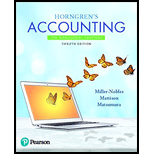
Horngren's Accounting (12th Edition)
12th Edition
ISBN: 9780134486444
Author: Tracie L. Miller-Nobles, Brenda L. Mattison, Ella Mae Matsumura
Publisher: PEARSON
expand_more
expand_more
format_list_bulleted
Question
Chapter 21, Problem 10QC
To determine
Concept introduction:
Breakeven point for two products: The Breakeven point is level of sales at which the net profit is zero. In other words, the breakeven point is the amount of sales at which there no loss and no profit. The formula to calculate breakeven point for two products is as follows:
Weighted average contribution margin per unit is calculated as follows:
To determine: The breakeven point for total guests, regular guests and discount guests.
Expert Solution & Answer
Want to see the full answer?
Check out a sample textbook solution
Chapter 21 Solutions
Horngren's Accounting (12th Edition)
Ch. 21 - For Frank’s Funky Sounds, straight-line...Ch. 21 - Prob. 2QCCh. 21 - Prob. 3QCCh. 21 - Prob. 4QCCh. 21 - Prob. 5QCCh. 21 - On a CVP graph, the total cost line intersects the...Ch. 21 - If a company increases its sales price per unit...Ch. 21 - Prob. 8QCCh. 21 - Prob. 9QCCh. 21 - Prob. 10QC
Ch. 21 - Donovan Company incurred the following costs while...Ch. 21 - Prob. 12AQCCh. 21 - Prob. 1RQCh. 21 - Prob. 2RQCh. 21 - What is a mixed cost? Give an example.Ch. 21 - What is the purpose of using the high-low method?Ch. 21 - Describe the three steps of the high-low method.Ch. 21 - What is the relevant range?Ch. 21 - A chain of convenience stores has one manager per...Ch. 21 - A chain of convenience stores has one manager per...Ch. 21 - Prob. 9RQCh. 21 - Prob. 10RQCh. 21 - Prob. 11RQCh. 21 - What is cost-volume-profit analysis?Ch. 21 - Prob. 13RQCh. 21 - Prob. 14RQCh. 21 - Prob. 15RQCh. 21 - Of the three approaches to calculate sales...Ch. 21 - Prob. 17RQCh. 21 - Prob. 18RQCh. 21 - On the CVP graph, where is the breakeven point...Ch. 21 - What is sensitivity analysis? How do managers use...Ch. 21 - Prob. 21RQCh. 21 - What is cost stickiness? Why do managers need to...Ch. 21 - Prob. 23RQCh. 21 - What is a company's cost structure? How can cost...Ch. 21 - What is operating leverage? What does it mean if a...Ch. 21 - Prob. 26RQCh. 21 - What is absorption costing?Ch. 21 - What is variable costing?Ch. 21 - How are absorption costing and variable costing...Ch. 21 - When units produced equal units sold, how does...Ch. 21 - Prob. 31ARQCh. 21 - Prob. 32ARQCh. 21 - Identifying variable, fixed, and mixed costs...Ch. 21 - Prob. S21.2SECh. 21 - Using the high-low method Learning Objective 1...Ch. 21 - Prob. S21.4SECh. 21 - Prob. S21.5SECh. 21 - Prob. S21.6SECh. 21 - Prob. S21.7SECh. 21 - Computing contribution margin, units and required...Ch. 21 - Prob. S21.9SECh. 21 - Prob. S21.10SECh. 21 - Prob. S21.11SECh. 21 - Use the following information to complete Short...Ch. 21 - Use the following information to complete Short...Ch. 21 - Prob. S21.14SECh. 21 - Prob. S21.15SECh. 21 - Prob. S21.16SECh. 21 - Prob. S21.17SECh. 21 - S21A-18 Classifying costs
Learning Objective 6...Ch. 21 - Use the following information for Short Exercises...Ch. 21 - Prob. S21A.20SECh. 21 - Prob. S21A.21SECh. 21 - Prob. S21A.22SECh. 21 - Prob. S21A.23SECh. 21 - Prob. S21A.24SECh. 21 - Prob. S21A.25SECh. 21 - Prob. S21A.26SECh. 21 - Prob. E21.27ECh. 21 - Prob. E21.28ECh. 21 - Prob. E21.29ECh. 21 - Prob. E21.30ECh. 21 - Prob. E21.31ECh. 21 - Prob. E21.32ECh. 21 - Prob. E21.33ECh. 21 - Prob. E21.34ECh. 21 - Prob. E21.35ECh. 21 - Prob. E21.36ECh. 21 - Prob. E21.37ECh. 21 - Prob. E21.38ECh. 21 - Prob. E21.39ECh. 21 - Prob. E21.40ECh. 21 - Prob. E21.41ECh. 21 - Prob. E21.42ECh. 21 - Prob. E21.43ECh. 21 - Prob. E21.44ECh. 21 - Prob. E21.45ECh. 21 - Prob. E21A.46ECh. 21 - Prob. E21A.47ECh. 21 - Prob. E21A.48ECh. 21 - Prob. E21A.49ECh. 21 - Prob. E21A.50ECh. 21 - Prob. E21A.51ECh. 21 - Prob. E21A.52ECh. 21 - Prob. E21A.53ECh. 21 - Prob. P21.54APGACh. 21 - Prob. P21.55APGACh. 21 - Analyzing CVP relationships Learning Objectives...Ch. 21 - Prob. P21.57APGACh. 21 - Prob. P21.58APGACh. 21 - Prob. P21A.59APGACh. 21 - Prob. P21A.60APGACh. 21 - Prob. P21.61BPGBCh. 21 - Prob. P21.62BPGBCh. 21 - Prob. P21.63BPGBCh. 21 - Prob. P21.64BPGBCh. 21 - Prob. P21.65BPGBCh. 21 - Prob. P21A.66BPGBCh. 21 - Prob. P21A.67BPGBCh. 21 - Using Excel for cost-volume-profit(CVP) analysis...Ch. 21 - Prob. P21.69CPCh. 21 - Comprehensive Problem for Chapters 18- 21 The...Ch. 21 - Comprehensive Problem for Chapters 18- 21 The...Ch. 21 - Comprehensive Problem for Chapters 18- 21 The...Ch. 21 - Comprehensive Problem for Chapters 18- 21 The...Ch. 21 - Comprehensive Problem for Chapters 18- 21 The...Ch. 21 - Prob. 6CPCh. 21 - Prob. 21.1TIATCCh. 21 - Prob. 21.1DCCh. 21 - Prob. 21.1EI
Knowledge Booster
Recommended textbooks for you

 AccountingAccountingISBN:9781337272094Author:WARREN, Carl S., Reeve, James M., Duchac, Jonathan E.Publisher:Cengage Learning,
AccountingAccountingISBN:9781337272094Author:WARREN, Carl S., Reeve, James M., Duchac, Jonathan E.Publisher:Cengage Learning, Accounting Information SystemsAccountingISBN:9781337619202Author:Hall, James A.Publisher:Cengage Learning,
Accounting Information SystemsAccountingISBN:9781337619202Author:Hall, James A.Publisher:Cengage Learning, Horngren's Cost Accounting: A Managerial Emphasis...AccountingISBN:9780134475585Author:Srikant M. Datar, Madhav V. RajanPublisher:PEARSON
Horngren's Cost Accounting: A Managerial Emphasis...AccountingISBN:9780134475585Author:Srikant M. Datar, Madhav V. RajanPublisher:PEARSON Intermediate AccountingAccountingISBN:9781259722660Author:J. David Spiceland, Mark W. Nelson, Wayne M ThomasPublisher:McGraw-Hill Education
Intermediate AccountingAccountingISBN:9781259722660Author:J. David Spiceland, Mark W. Nelson, Wayne M ThomasPublisher:McGraw-Hill Education Financial and Managerial AccountingAccountingISBN:9781259726705Author:John J Wild, Ken W. Shaw, Barbara Chiappetta Fundamental Accounting PrinciplesPublisher:McGraw-Hill Education
Financial and Managerial AccountingAccountingISBN:9781259726705Author:John J Wild, Ken W. Shaw, Barbara Chiappetta Fundamental Accounting PrinciplesPublisher:McGraw-Hill Education


Accounting
Accounting
ISBN:9781337272094
Author:WARREN, Carl S., Reeve, James M., Duchac, Jonathan E.
Publisher:Cengage Learning,

Accounting Information Systems
Accounting
ISBN:9781337619202
Author:Hall, James A.
Publisher:Cengage Learning,

Horngren's Cost Accounting: A Managerial Emphasis...
Accounting
ISBN:9780134475585
Author:Srikant M. Datar, Madhav V. Rajan
Publisher:PEARSON

Intermediate Accounting
Accounting
ISBN:9781259722660
Author:J. David Spiceland, Mark W. Nelson, Wayne M Thomas
Publisher:McGraw-Hill Education

Financial and Managerial Accounting
Accounting
ISBN:9781259726705
Author:John J Wild, Ken W. Shaw, Barbara Chiappetta Fundamental Accounting Principles
Publisher:McGraw-Hill Education